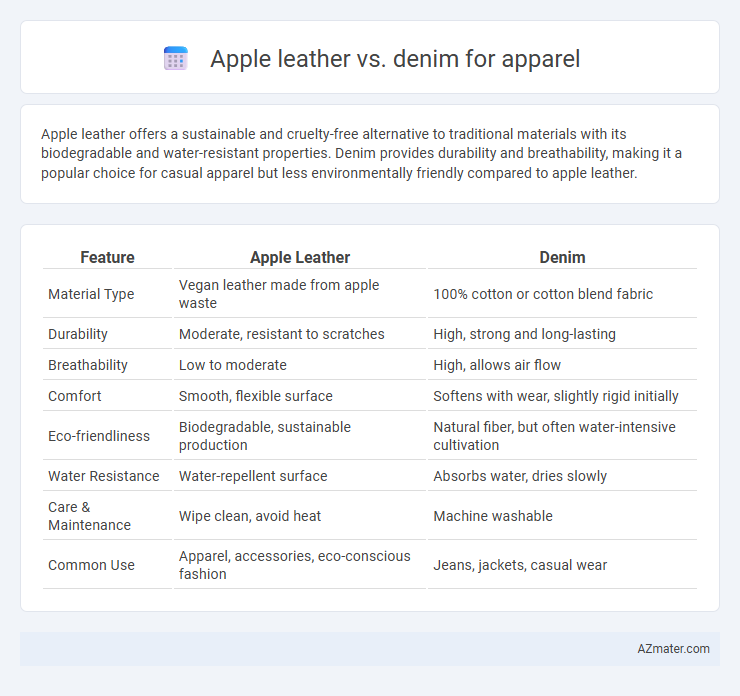Apple leather offers a sustainable and cruelty-free alternative to traditional materials with its biodegradable and water-resistant properties. Denim provides durability and breathability, making it a popular choice for casual apparel but less environmentally friendly compared to apple leather.
Table of Comparison
| Feature | Apple Leather | Denim |
|---|---|---|
| Material Type | Vegan leather made from apple waste | 100% cotton or cotton blend fabric |
| Durability | Moderate, resistant to scratches | High, strong and long-lasting |
| Breathability | Low to moderate | High, allows air flow |
| Comfort | Smooth, flexible surface | Softens with wear, slightly rigid initially |
| Eco-friendliness | Biodegradable, sustainable production | Natural fiber, but often water-intensive cultivation |
| Water Resistance | Water-repellent surface | Absorbs water, dries slowly |
| Care & Maintenance | Wipe clean, avoid heat | Machine washable |
| Common Use | Apparel, accessories, eco-conscious fashion | Jeans, jackets, casual wear |
Introduction: Apple Leather vs Denim in Apparel
Apple leather offers a sustainable and cruelty-free alternative to traditional materials in apparel, made from apple waste and boasting durability and breathability. Denim, a classic fabric derived from cotton, is renowned for its strength, versatility, and timeless style in clothing. Comparing apple leather and denim highlights differences in texture, environmental impact, and use cases within fashion design.
Material Origins and Sustainability
Apple leather is derived from the byproducts of the apple juice and cider industry, utilizing apple peel and core waste to create a biodegradable and eco-friendly alternative to traditional leather. Denim, typically made from cotton, relies on intensive water usage and synthetic dyes, which can strain water resources and contribute to pollution in apparel manufacturing. The sustainable appeal of apple leather lies in its circular economy potential and lower environmental footprint compared to conventional denim production, which often depends on resource-heavy agricultural practices.
Environmental Impact Comparison
Apple leather significantly reduces environmental impact compared to traditional denim by utilizing upcycled apple peels, minimizing agricultural waste and lowering water consumption by up to 80%, whereas denim production requires large amounts of water and pesticides for cotton cultivation. The biodegradable nature of apple leather also contributes to decreased landfill waste, unlike synthetic denim blends which can persist in the environment for decades. By integrating renewable biomass inputs, apple leather supports a circular economy model, contrasting with the high carbon footprint and soil degradation associated with conventional denim manufacturing.
Durability and Longevity
Apple leather offers excellent durability, resisting wear and tear while maintaining its texture over time, making it a sustainable alternative to traditional leather. Denim is known for its robust fiber strength and ability to withstand repeated washing and abrasion, ensuring long-lasting apparel performance. While denim excels in rugged longevity, apple leather combines eco-friendly benefits with durability, creating a versatile choice for durable, long-lasting fashion.
Comfort and Wearability
Apple leather offers superior softness and flexibility compared to traditional denim, enhancing overall comfort during extended wear. Its breathable, lightweight nature reduces skin irritation, making it ideal for sensitive skin and all-day apparel use. Denim, while durable and rugged, tends to be stiffer and less breathable, often requiring a break-in period before reaching optimal comfort levels.
Style Versatility and Aesthetic Appeal
Apple leather offers a sleek, modern aesthetic with a smooth texture that enhances contemporary and minimalist styles, making it ideal for sophisticated apparel pieces. Denim provides a timeless, rugged appeal with diverse washes and finishes that adapt effortlessly to casual, streetwear, and vintage-inspired looks. Both materials serve as versatile options, but apple leather elevates fashion-forward designs while denim maintains enduring popularity across various style genres.
Maintenance and Care Requirements
Apple leather requires gentle cleaning with a damp cloth and mild soap to maintain its texture and prolong durability, avoiding harsh chemicals or machine washing which can damage its surface. Denim is more resilient in maintenance, allowing regular machine washing, though it is recommended to wash in cold water and air dry to prevent fading and shrinkage. Both materials benefit from avoiding excessive heat exposure and storing in a cool, dry place to ensure longevity.
Cost and Market Availability
Apple leather, derived from apple waste, typically commands higher prices due to its sustainable production process and limited scale, while denim remains more cost-effective and widely available owing to established manufacturing infrastructure and abundant raw materials. Market availability of apple leather is currently niche, primarily found in eco-conscious fashion brands, whereas denim dominates global apparel markets with extensive distribution networks and price accessibility. Consumers seeking affordable, durable fabrics often prefer denim, whereas those prioritizing environmental sustainability may invest in apple leather despite higher costs and limited retail presence.
Ethical Considerations in Fashion
Apple leather offers an ethical advantage over denim by utilizing sustainable, biodegradable materials derived from apple waste, reducing reliance on traditional animal leather and synthetic fabrics. Denim production often involves intensive water usage and chemical treatments that raise environmental and ethical concerns related to pollution and resource depletion. Choosing apple leather promotes cruelty-free fashion and supports circular economy initiatives, aligning with growing consumer demand for eco-friendly apparel alternatives.
Future Trends: Apple Leather and Denim in Apparel
Apple leather offers a sustainable alternative to traditional textiles, gaining traction due to its eco-friendly properties and innovative production methods that reduce waste in the apparel industry. Denim continues to evolve with advancements like waterless dyeing and blended fibers incorporating recycled materials, enhancing durability and environmental impact. Future trends highlight a convergence where apple leather accents or panels are integrated into denim garments, creating hybrid apparel that meets consumer demand for style, sustainability, and performance.

Infographic: Apple leather vs Denim for Apparel
 azmater.com
azmater.com